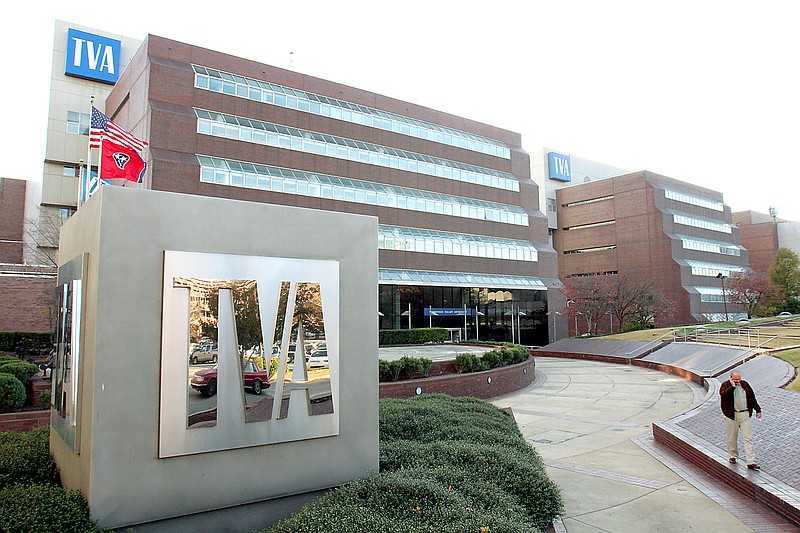KNOXVILLE - The average Chattanooga household will pay nearly $2 more a month for electricity, starting in October, to help fund a $10.4 billion budget plan for the Tennessee Valley Authority in fiscal 2017.
TVA directors voted Thursday to raise power rates by 1.5 percent in the fiscal year that starts Oct. 1 to help generate another $192 million to help absorb the costs of bringing the newest nuclear reactor into the rate base.
At the same time, TVA will cut another $104 million in operating expenses next year, primarily through more voluntary reductions in its 10,792-employee staff, which is already at the lowest level for TVA since 1934, just a year after the agency was established as part of Franklin Roosevelt's New Deal.
The rate increase for next year matches the rate hikes adopted by TVA in each of the past two years. TVA President Bill Johnson said such increases are less than the inflation rate and will still leave TVA rates below the U.S. average and relatively better than where the agency stood against other utilities in the past.
"In the last few years, we've gotten more competitive with these incremental rate increases while we continue to bend debt and spending down," Johnson said. "Our market is changing, and we and our customers are working to adapt to new business conditions that include reduced energy needs and increased demand for energy efficiencies and renewables."
Aided by cheaper fuel, more efficient power plants and fewer purchases of more expensive power, TVA has offset its base rate increases with cuts in its fuel cost adjustments. That has reduced the delivered price of its electricity by more than 5 percent in the past five years, even as power demand remains relatively flat.
"We've managed our business to a low-cost structure as businesses and consumers use less energy," Johnson said.
TVA Chief Financial Officer John Thomas said the growth in power demand continues to slow and TVA now expects long-term growth of only 0.3 percent a year - and even less with energy efficiency measures or a slower economy.
"Every time, I look at our power forecasts the growth rate seems to be going lower," Thomas told TVA directors. "Maybe I should quit looking at these forecasts."
But even as consumers cut their power use with more efficient lights, appliances, air conditioners and furnaces, TVA still plans to spend $2.9 billion in capital expenditures next year to build new gas plants to replace older, dirtier coal plans in Memphis and Paradise, Ky., and to install more pollution controls on the coal plants TVA will continue to operate.
But TVA's capital budget is down from the peak of $3.4 billion reached in 2015 and down slightly from the $2.9 billion being spent this year.
TVA has spent $4.7 billion over the past seven years to finish a second reactor at Watts Bar Nuclear Power Plant, which began generating power for the first time in May. The Unit 2 reactor at Watts Bar near Spring City, Tenn., is still undergoing a series of power ascension tests for new plants. The new reactor - the first nuclear unit to come on line in America in more than two decades - has had a number of shutdowns, both planned and unplanned this summer, as the new equipment is tried out for the first time.
Mike Skaggs, the TVA senior vice president heading up the Watts Bar project, said the unit is being restarted after a feedwater pump problem shut it down Tuesday. The unit should be brought to full power in the next month, he said.
Once the plant has reached 100 percent of its 1,150-megawatt power production level for at least 20 days, and achieves other milestones, the plant will be declared a commercial power plant and the expense of building the plant will be brought into the rate base and added to TVA's operating costs. So far, the cost of building and testing the plant has been capitalized and paid with borrowed funds.
Johnson said bringing Watts Bar Unit 2 into the rate base will add about $200 million a year to TVA's operating expenses.
TVA is also looking to buy more solar and wind power. The utility says it already gets 13 percent of its power from hydro, wind and solar power.
But with power demand expected to remain relatively stagnant in the next year, TVA has no plans to build any major new nuclear or coal plants for at least the next 20 years. Johnson said even with stronger economic growth, energy conservation and efficiency measures being taken by consumers are offsetting that growth and limiting overall growth in electricity.
Last month, for instance, a 96-degree temperature day pushed TVA's power load to a summertime high of 29,751 megawatts. The same temperature and conditions in 2007 required TVA to supply more than 32,000 megawatts of power, or 7 percent more.
But even as consumers are using energy conservation and efficiency to cut their demand, major power users still urged TVA to try to do more t0 avoid future rate increases.
"We understand the need for occasional rate adjustments," said Peter Mattheis, chairman of the Tennessee Valley Industrial Committee, which represents the largest industrial customers that buy TVA power. "But we are concerned with the regular nature of rate increases. We have members who compete both regionally and globally in commodity businesses and they are not able to increase their prices, so they have to absorb any cost increases."
Contact staff writer Dave Flessner at dflessner@timesfreepress.com or 423-757-6340.
